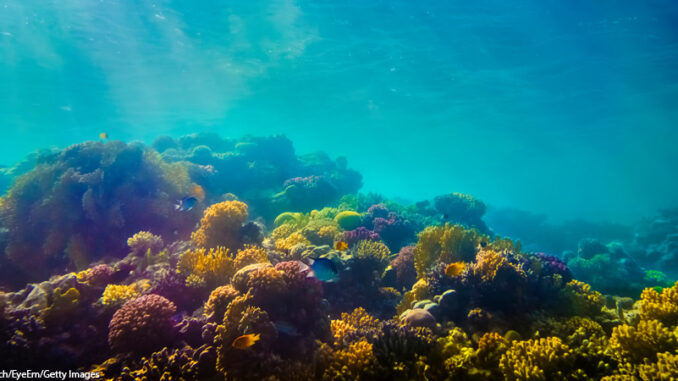
Coral Reefs Show Damage From Climate Change
Coral reefs are important for many reasons. They support about one-fourth of all fish species on Earth. They also help protect and shield coastlines from storms. But coral reefs are dying off at an alarming rate. The Global Coral Reef Monitoring Network recently published a report analyzing data from two million observations at more than 12,000 collection sites in 73 countries over forty years (1978 to 2019). Between 2008 and 2019, the world lost about 14 percent of its total amount of coral reefs. This amount is the equivalent of all of the living coral in Australia. Speaking of Australia: the Great Barrier Reef has experienced three mass bleaching events–where the coral dies off, leaving only the white “skeleton” behind–in the past five years. Scientists say that this damage is the result of the ongoing and prolonged effects of warming ocean surface temperatures. Other elements that cause damage to coral reefs include overfishing, increasing carbon dioxide levels in the water, new development along coasts, and declining water quality.
In May 2021, another study from New Zealand’s Victoria University of Wellington revealed that at this rate, coral growth may stop altogether. Coral must continuously grow to make up for the fact that it is battered by waves and eaten away at by some types of fish. But the warmer ocean temperatures keep it from growing, and the increasing water acidity caused by rising carbon dioxide levels erodes reefs and makes it harder for the coral to rebuild its “skeleton.”
The one bright bit of news? Coral is resilient. Scientists are studying ways to restore reefs by “breeding” coral that is more resistant to warmer temperatures.
Dig Deeper Create a poster informing your classmates about the effects of climate change on coral reefs. Suggest some specific things they can do to become more climate-conscious in their everyday lives.
Midwest Governors Form Electric Vehicle Coalition
Midwestern electric vehicle owners can be happy about a new plan that was signed last week. The governors of five Midwestern states–J.B. Pritzker of Illinois, Eric Holcomb of Indiana, Gretchen Whitmer of Michigan, Tim Walz of Minnesota, and Tony Evers of Wisconsin–have agreed to form the Regional Electric Vehicle Midwest Coalition. The bipartisan REV Midwest plan aims to reduce gasoline emissions and help transition the region to widespread electric vehicle usage. REV Midwest will remove barriers to electric vehicle adoption by making it easier to find charging stations, coordinate electric vehicle regulations between the five states, and encourage new technology. It will also create new jobs in a changing economy.
So how will all of this be achieved? The coalition will form a leadership task force made up of members from each of the participating states. The task force will meet regularly to update information, revisit goals, identify challenges, and remove barriers to implementation. The task force will also complete regular progress reports to submit to REV Midwest.
What Do You Think? Use Internet resources to determine how the Midwest compares to other regions of the country in terms of electric vehicle usage. Would you consider the Midwest to be a leader, or is it lagging behind? Do you think this coalition will be successful at increasing the number of electric vehicles in the Midwest? Explain.
The Remarkable Story of Dr. Saleema Rehman
On September 29, 2021, Dr. Saleema Rehman won the United Nation’s High Commissioner for Refugees (UNHCR) annual Nansen Award. This award is given to people who do exceptional work for displaced persons and refugees. .
Dr. Rehman is the first female refugee doctor from Afghanistan’s Turkmen ethnic group. Women in the Turkmen community are taught to become carpet weavers, and often marry when they’re quite young. But Dr. Rehman’s life followed a different path because of her father’s vision and Dr. Rehman’s hard work. In 1979, her parents escaped the Soviet War in Afghanistan. They lived in refugee camps in Pakistan for many years. While there, Dr. Rehman’s mother became pregnant and gave birth to her. The birth was complicated, and there was no medical care in the camps. Both she and her infant daughter nearly died. Dr. Rehman’s father pledged that his daughter would grow up to be a doctor, and that is exactly what she did.
Today, Dr. Rehman is 29 years old and a gynecologist–a medical field she chose because of her mother’s ordeal giving birth to her. She currently works in the city of Attock, Pakistan, where she provides medical services to Afghan refugee women. But her road has not been an easy one. With the help of her father, Abdul, Dr. Rehman overcame her community’s reluctance to educate women. She also sought out, and won, scholarships to help pay for her education. After completing her medical residency in Pakistan, she specialized in gynecology and tried to open up her own practice. But in Pakistan, refugees don’t have the right to open their own businesses. Dr. Rehman did not give up, and was eventually awarded a license to operate her own clinic, which she continues to do today.
Dr. Rehman won the Nansen Refugee award because of her commitment to improving the health care for Pakistanis and refugees living in Pakistan. The award also recognizes Dr. Rehman’s own history as a refugee and the commitment the doctor has demonstrated for achieving her career as a gynecologist.
Dig Deeper Conduct more research on Dr. Saleema Rehman to learn more about her life and the challenges she has overcome. Write a two paragraph summary of your findings.
Hurricane Drones
Recently collected data shows that hurricane season is lasting longer and becoming more intense every year. In 2021, there have been eighteen named storms, making this hurricane season the third most active in history. (The first was 2020 and the second was 2005.)
Scientists at the National Oceanic and Atmospheric Administration (NOAA) have placed five surface drones into the Atlantic Ocean. These drones look like large buoys and are equipped with cameras and monitoring equipment. The goal is to use the drones to gather data and video footage. This data will help scientists learn all they can about the way hurricanes form and move. That way, they can improve storm forecasting models and hopefully save lives.
Recently, Hurricane Sam–a category 4 storm–spun in the Caribbean Sea for nearly a week, making it one of the longest-lasting hurricanes in history. NOAA scientists dispatched one of the drones (the Saildrone Explorer SD 1045) directly into it. The drone recorded and transmitted lots of video footage of 50-foot waves, 120 mph winds, and slate-gray skies. While Hurricane Sam didn’t make landfall anywhere, it did produce high waves and riptides in Bermuda and the Bahamas.
The 2021 hurricane season ends on November 30. Scientists originally estimated that there would be thirteen to twenty named storms this year. With one and a half months to go in the season, it’s likely that there will end up being more than predicted.

